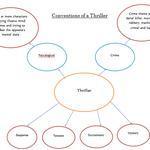Write a thriller: 2 tips to get your book started
Just write, don't wait for inspiration. And understand the 3-Act structure

Nora Roberts (aka J.D. Robb) knows what she's talking about. To get going on your thriller -- or any other kind of writing -- you have to just do it. Don't worry about how it sounds or feels. Just write. She has 209 romance novels and a bunch of crime fiction to her name proving that she's right. The somewhat less prolific Ernest Hemingway said that "first drafts are shit." But all novels have a first draft. So get your Hemingwayesque excrement out there and then you can start to mould it into... Ah, let's move on.
The basic outline of a thriller plot -- or of any other crime story -- looks like this:

The part we're going to chat about in this post is up top:

Why three acts? Shakespeare used five, but three is the way most stories are told today. (I've included the idea of a fourth act, which we'll go into later.) You set things up in Act 1. The hero must push on into the story or something dreadful's going to happen. In Act 2, the hero chases about. The hero tries to figure out what's in his way. In Act 3, the hero knows what he has to do to wrap things up. So he sets about doing it.
We'll move down the plot diagram in the posts I'll be adding to my blog this week. Keep reading.
Related articles across the web
 Tyson Adams' Rules of Thriller Writing
Tyson Adams' Rules of Thriller Writing
 thriller movie conventions
thriller movie conventions
 Conventions of a Thriller
Conventions of a Thriller

Nora Roberts (aka J.D. Robb) knows what she's talking about. To get going on your thriller -- or any other kind of writing -- you have to just do it. Don't worry about how it sounds or feels. Just write. She has 209 romance novels and a bunch of crime fiction to her name proving that she's right. The somewhat less prolific Ernest Hemingway said that "first drafts are shit." But all novels have a first draft. So get your Hemingwayesque excrement out there and then you can start to mould it into... Ah, let's move on.
The basic outline of a thriller plot -- or of any other crime story -- looks like this:

The part we're going to chat about in this post is up top:

Why three acts? Shakespeare used five, but three is the way most stories are told today. (I've included the idea of a fourth act, which we'll go into later.) You set things up in Act 1. The hero must push on into the story or something dreadful's going to happen. In Act 2, the hero chases about. The hero tries to figure out what's in his way. In Act 3, the hero knows what he has to do to wrap things up. So he sets about doing it.
We'll move down the plot diagram in the posts I'll be adding to my blog this week. Keep reading.
Related articles across the web
 Tyson Adams' Rules of Thriller Writing
Tyson Adams' Rules of Thriller Writing  thriller movie conventions
thriller movie conventions  Conventions of a Thriller
Conventions of a Thriller
Published on February 24, 2014 02:24
•
Tags:
crime-fiction, j-d-robb, nora-roberts, thrillers, writing, writing-tips
No comments have been added yet.



